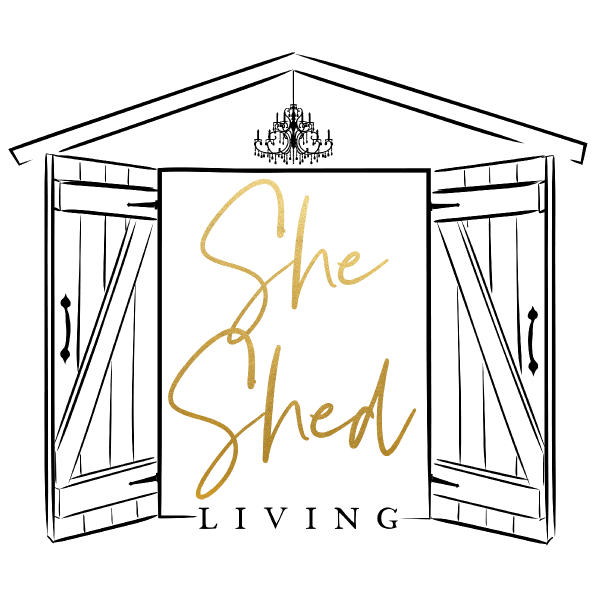The easiest way to dress up a she shed is to put green, living plants inside. Learn about nine of the top indoor plants that are easy to grow, add natural beauty to your space and actually purify the air around you.

(Disclosure: This post may contain affiliate links, meaning we get a commission if you decide to make a purchase through our links, at no cost to you. Please read our disclosure page for more info.)
There are two secrets to interior beauty: paint and plants. Nothing adds more visual interest to your favorite reading nook or your she shed as these two, and indoor plants add something more: air purification.
According to the American Lung Association, indoor plants can help filter toxins from the air. In a study by the University of Georgia, it was found that plants can remove up to 87% of toxins from the air in just 24 hours. Indoor air can be tainted with pollutants; according to the Environmental Protection Agency, the air inside our homes is 2-5 times more polluted than the air outside. Plants can help! There are many different kinds of toxins that plants can help remove from the air, including:
Volatile organic compounds (VOCs)
Benzene
Formaldehyde
Some of the best plants for filtering toxins from the air include:
Spider plants
Aloe vera
Bamboo palm
Rubber plant
Dracaena
Emily Houston, plant expert and avid gardener at Gardeners Path, says that “if you’re looking to improve the air quality in your home, consider adding some of these indoor plants to your décor. Not only will they help filter toxins from the air, but they’ll also add a touch of nature to your space.” The following is a list of Houston’s favorites.
Aloe Vera

Aloe vera is a succulent plant that is easy to care for and can thrive in both bright light and low light. This makes it a great option for your she shed. Aloe vera is also known for its healing properties and can be used to treat sunburns and other skin conditions.
If you’re looking for a plant that will add a touch of beauty to your she shed, consider adding an aloe vera plant. Not only is it easy to care for, but it can also help purify the air in your shed.
Maintenance tips: water aloe vera plants about once a week, allowing the soil to dry out between watering.
Snake Plant

The snake plant is another easy to care for plant that can tolerate both bright light and low light. This plant is also known for its air purifying properties, making it a great choice for your she shed.
If you’re looking for a unique, low-maintenance plant to add to your she shed, consider the snake plant. Also known as the mother-in-law’s tongue, this striking succulent is perfect for those who want a bit of greenery without having to worry about too much care. Snake plants are known for being tough and drought-resistant, so they’re perfect for those who want a plant that can survive a bit of neglect.
And, because they don’t need much water, they’re also great for sheds that don’t have a lot of natural light.
Maintenance tips: water snake plants about once a week, allowing the soil to dry out between watering.
Golden Pothos

Golden pothos is a trailing plant that adds visual drama to the shed with its striking gold and green leaves. This plant is easy to care for and can tolerate both bright light and low light.
Often called “devil’s Ivy,” this fast-growing vine is incredibly easy to care for, making it a great option for those who may not have a lot of experience with plants. Vines are great for sheds because they soften exposed studs and other stark architectural details.
The golden pothos is a very popular houseplant because it is an excellent air purifier, removing a variety of toxins from the air. Golden pothos can be grown in soil or water, making it a versatile plant for any home.
Maintenance tips: water golden pothos about once a week, allowing the soil to dry out between watering.
Spider Plant

If you’re looking for a plant that will thrive in your she shed or office, then consider the spider plant. This hardy and fast-growing plant is easy to care for and can tolerate low light conditions, making it ideal for indoor spaces. The spider plant is also a proven air purifier. In a NASA study, spider plants placed in closed chambers with 120 parts per million (ppm) of carbon monoxide removed 96 percent of the contaminant in 24 hours.
Maintenance tips: water spider plants about once a week, allowing the soil to dry out between watering.
Philodendron

The philodendron is a fast-growing plant that is easy to care for. It does well in almost any environment. Philodendrons are known for their ability to purify the air by trapping dust and producing oxygen. Their large, dark-green leaves efficiently capture both light and moisture.
This tough and easy-to-care-for plant is perfect for anyone who wants to add a touch of greenery to their space without having to worry about watering or fertilizing too often. Plus, the philodendron’s beautiful leaves will add a touch of color and life to your shed.
When it comes to light, the philodendron is pretty versatile and can tolerate both low and bright light conditions. However, if you want your plant to really thrive, it’s best to give it bright, indirect light. Watering wise, the philodendron doesn’t need much. Allow the top few inches of soil to dry out before watering again and you should be good to go.
Maintenance tips: water philodendrons about once a week, allowing the soil to dry out between watering.
Peace Lily

The peace lily is a beautiful plant that is easy to care for. It does well in both bright light and low light. Peace lilies are known for their ability to purify the air and can help to improve the air quality in your shed.
If you’re looking for a beautiful, low-maintenance plant to spruce up your she shed, look no further than the peace lily! This hardy plant can tolerate both low light and high humidity, making it the perfect choice for your indoor space. Plus, its white blooms are a stunning addition to any room.
Maintenance tips: water peace lilies about once a week, allowing the soil to dry out between watering.
Boston Fern

The Boston fern is a classic indoor plant that does well in both bright light and low light. It is a great choice because it doesn’t require a lot of care and can survive in less than ideal conditions. Ferns have been popular houseplants since the Victorian era, for their exquisite foliage (the word “fern” comes from the ancient Anglo Saxon word “fearn,” meaning feather).
Boston ferns are especially effective at removing formaldehyde from the air, making them ideal for use in homes where there is a lot of indoor pollution. These hardy plants can also help to reduce the level of mold spores in the air, making them a good choice if you suffer from allergies.
When it comes to choosing a pot for your Boston fern, opt for one that is slightly larger than the plant’s current container. This will give the roots plenty of room to grow and allow the plant to thrive. Be sure to use a well-draining potting mix, as ferns do not like to sit in water.
Maintenance tips: water Boston ferns about once a week, allowing the soil to dry out between watering.
Dracaena

The dracaena is a beautiful plant that does well in both bright light and low light. It is a great choice for your she shed because it doesn’t require a lot of care and can survive in less than ideal conditions. Dracaenas are also known for their ability to purify the air and can help to improve the air quality in your shed.
Dracaena doesn’t require a lot of sunlight. It also has air-purifying properties, which is always a bonus. Plus, its long, sweeping leaves add a touch of elegance to any space; note how the light illuminates the leaves’ variegated streaks.
Maintenance tips: water dracaenas about once a week, allowing the soil to dry out between watering.
Ficus

The ficus is a lush plant that does well in both bright light and low light. It is a great choice for your she shed because it doesn’t require a lot of care and can survive in less than ideal conditions. Ficus are also known for their ability to purify the air and can help to improve the air quality in your shed.
Ficus (also called “weeping figs”) are relatively easy to care for, and should be grown in pots and kept pruned because they have a robust root system. The leaves of a ficus tree are known to have natural anti-inflammatory properties, so having one in your she shed could help you to relax and de-stress.
Maintenance tips: water ficus about once a week, allowing the soil to dry out between watering.
Don’t Overwater!
The most common problem for indoor plants is too much water. According to Emily Houston, all of these plants may develop root rot if they are saturated constantly. Take the time to touch the soil with your fingers before tipping the watering can. If it’s still damp to about an inch down, wait.




Will putting these plants in your she shed during the winter without any heat be too cold for the plants in zones 7b and 8, or do they need a heat source. If they need heat, what’s the most economical source?
Hi Carla, if your shed is well sealed (like a garage) then your plants may be fine. For a low-cost heat source you can also try insulating the pots with burlap or quilts, to protect the roots. It will be an experiment, though, as some indoor plants tolerate the cold much better than others. When in doubt, bring them into the house.